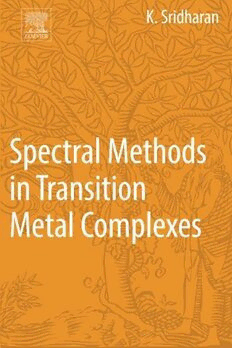Table Of ContentSpectral Methods in Transition
Metal Complexes
Spectral Methods in Transition
Metal Complexes
K.Sridharan
SchoolofChemicalandBiotechnology
SASTRAUniversity
Thanjavur
TamilNadu
India
AMSTERDAM (cid:129) BOSTON (cid:129) HEIDELBERG (cid:129) LONDON (cid:129) NEW YORK (cid:129) OXFORD
PARIS (cid:129) SAN DIEGO (cid:129) SAN FRANCISCO (cid:129) SINGAPORE (cid:129) SYDNEY (cid:129) TOKYO
Elsevier
Radarweg29,POBox211,1000AEAmsterdam,Netherlands
TheBoulevard,LangfordLane,Kidlington,OxfordOX51GB,UK
50HampshireStreet,5thFloor,Cambridge,MA02139,USA
Copyright©2016ElsevierInc.Allrightsreserved.
Nopartofthispublicationmaybereproducedortransmittedinanyformorbyanymeans,electronicor
mechanical,includingphotocopying,recording,oranyinformationstorageandretrievalsystem,
withoutpermissioninwritingfromthepublisher.Detailsonhowtoseekpermission,further
informationaboutthePublisher’spermissionspoliciesandourarrangementswithorganizationssuchas
theCopyrightClearanceCenterandtheCopyrightLicensingAgency,canbefoundatourwebsite:
www.elsevier.com/permissions.
Thisbookandtheindividualcontributionscontainedinitareprotectedundercopyrightbythe
Publisher(otherthanasmaybenotedherein).
Notices
Knowledgeandbestpracticeinthisfieldareconstantlychanging.Asnewresearchandexperience
broadenourunderstanding,changesinresearchmethods,professionalpractices,ormedicaltreatment
maybecomenecessary.
Practitionersandresearchersmustalwaysrelyontheirownexperienceandknowledgeinevaluating
andusinganyinformation,methods,compounds,orexperimentsdescribedherein.Inusingsuch
informationormethodstheyshouldbemindfuloftheirownsafetyandthesafetyofothers,including
partiesforwhomtheyhaveaprofessionalresponsibility.
Tothefullestextentofthelaw,neitherthePublishernortheauthors,contributors,oreditors,assume
anyliabilityforanyinjuryand/ordamagetopersonsorpropertyasamatterofproductsliability,
negligenceorotherwise,orfromanyuseoroperationofanymethods,products,instructions,orideas
containedinthematerialherein.
BritishLibraryCataloguinginPublicationData
AcataloguerecordforthisbookisavailablefromtheBritishLibrary
LibraryofCongressCataloging-in-PublicationData
AcatalogrecordforthisbookisavailablefromtheLibraryofCongress
ForinformationonallElsevierpublications
visitourwebsiteathttp://store.elsevier.com/
ISBN:978-0-12-809591-1
LIST OF FIGURES
1.1 Electromagneticradiation.................................................. 2
1.2 Emissionofγ radiationfromanucleus................................. 4
1.3 EmissionofX-rayfromamolecule...................................... 5
1.4 EffectofUV-Visradiationonamolecule. ............................. 6
1.5 Electronictransitions........................................................ 7
1.6 EffectofIRradiationonamolecule..................................... 8
1.7 Effectofmicrowavesonamolecule..................................... 9
1.8 Effectofradiofrequencyonamolecule................................ 10
1.9 Effectofmicrowaveonthespinofelectron........................... 11
2.1 WatermoleculehavingC axisofsymmetry.......................... 15
2
2.2 MoleculehavingnoC axisofsymmetry.............................. 15
2
2.3 MoleculehavingC axisofsymmetry. ................................. 15
3
2.4 MoleculehavingC axisofsymmetry. ................................. 16
4
2.5 MoleculehavingC axisofsymmetry. ................................. 16
6
2.6 Moleculehavingσ planes................................................. 17
v
2.7 Horizontalmirrorplane,σ ................................................ 17
h
2.8 Dihedralplane,σ ............................................................ 17
d
2.9 Moleculewithcenterofsymmetry,i..................................... 18
2.10 MoleculewithS axisofrotation......................................... 18
4
2.11 Octahedralcomplex.......................................................... 19
2.12 Squareplanarcomplex...................................................... 19
2.13 Tetrahedralcomplex......................................................... 20
2.14 Thetermsarisingfromap2configurationandthestatesarising
fromthem. ..................................................................... 29
2.15 Effectofspin-orbitcouplingonpdconfiguration. ................... 30
2.16 MOdiagramforO complex.............................................. 32
h
2.17 MOdiagramfortetrahedral sigmaonlycomplex. ................... 35
ix
x ListofFigures
2.18 Orbitalandspinmotionsofanelectron................................. 36
2.19 TheorbitalsintheEterm................................................... 37
2.20 TheorbitalsintheTterm................................................... 37
2.21 OrgeldiagramforaDterm. ............................................... 41
2.22 OrgeldiagramforanFterm............................................... 41
2.23 SplittingofDandFterms.................................................. 43
2.24 Splittingofd-orbitalsundervariousgeometries...................... 45
2.25 Tanabe-Suganodiagramforad2 complex. ............................ 50
2.26 Tanabe-Suganodiagramford4 system.................................. 51
2.27 SpectrumofanaqueoussolutionofTi3+,ad1 system.............. 55
2.28 Theelectronic spectrumofCu2+,ad9 system........................ 56
2.29 Theelectronic spectrumofV3+,ad2 system.......................... 57
2.30 ElectronicspectrumofNi2+ ioninaqueoussolution................ 57
2.31 Theelectronic spectrumofanaqueoussolutionofCr3+........... 58
2.32 Theelectronic spectrumofCo2+ aqueoussolution.................. 58
2.33 TheTanabe-Suganodiagramforad7 system.......................... 59
2.34 ElectronicspectrumofCr2+ aqueoussolution........................ 59
2.35 ElectronicspectrumofanaqueoussolutionofFe2+................. 60
2.36 The electronic spectrum of an aqueous solution
ofMn2+......................................................................... 61
2.37 Electronicspectrumof[Co(en) ](ClO ) inwater................... 61
3 4 3
+
2.38 Electronicspectrumofcis-[Co(en) F ] ............................... 62
2 2
+
2.39 Electronicspectrumoftrans-[Co(en) F ] ............................ 62
2 2
3.1 Fundamentalvibrationsofthewatermolecule........................ 70
3.2 NormalmodesofvibrationofCO ...................................... 70
2
3.3 C operationonawatermolecule........................................ 73
2
3.4 σ operationonthewatermolecule...................................... 74
v
3.5 Notationofaxesandplanes................................................ 74
3.6 Symmetricandantisymmetricstretchings.............................. 76
3.7 BasissetforSALC........................................................... 76
3.8 Basisvectors................................................................... 77
3.9 Structureoftrans-N F ..................................................... 79
2 2
ListofFigures xi
3.10 EffectofC operationontrans-N F . .................................. 79
2 2 2
3.11 Effectofσ operationontrans-N F .................................... 80
h 2 2
3.12 Resonancestructuresofnitratoligand. ................................. 86
3.13 Nitratoligandasmonodentate............................................. 86
3.14 Nitratoligandassymmetricalbidentatechelate. ..................... 86
3.15 Nitratoligandasunsymmetricalbidentatechelate................... 86
3.16 Nitratoligandasbidentatebinuclear..................................... 86
3.17 Structureofcarboxylateligand. .......................................... 87
3.18 Carboxylateasamonodentateligand.................................... 87
3.19 Carboxylateasasymmetricalbidentatechelateligand. ............ 87
3.20 Carboxylateasabidentatebinuclearligand............................ 87
3.21 Structureoffreesulfateion................................................ 88
3.22 Sulfateasamonodentateligand. ......................................... 88
3.23 Sulfateasabidentatechelateligand..................................... 88
3.24 Sulfateasabidentatebridgingligand. .................................. 88
3.25 StructureofN,N-dimethylacetamide.................................... 89
3.26 MOdiagramofCN. ......................................................... 90
3.27 Resonancestructureofdimethylsulfoxide............................. 92
3.28 MOdiagramofcarbonmonoxideligand............................... 93
3.29 Different structures of metal carbonyls. (A) T .
d
(B)D h.(C)O ............................................................... 94
3 h
3.30 StructureofCo (CO) .(A)C v.(B)D d.............................. 94
2 8 2 3
3.31 StructureofFe (CO) ....................................................... 95
2 9
3.32 StructureofMn (CO) . ................................................... 95
2 10
4.1 SplittingoflevelsinEPRspectroscopy.(A)EPR.(B)NMR...... 100
4.2 (A)Normalcurve.(B)DerivativecurveinEPR...................... 100
4.3 HyperfinesplittinginEPR................................................. 101
4.4 EPRspectrumofcoppercomplex........................................ 102
4.5 g(cid:2) andg⊥....................................................................... 103
4.6 g(cid:2),g⊥,gxx,gyy,andgzz...................................................... 104
4.7 SplittingofenergylevelsofCu(II)indifferentfields. .............. 108
4.8 FlowchartexplainingKramer’sdegeneracy........................... 109
xii ListofFigures
4.9 SplittingoflevelswithoutKramer’s degeneracy. .................... 109
4.10 Energy levels of Mn(II) under zero-field splitting and
Kramer’sdegeneracy. ....................................................... 110
4.11 Structureofbis-salicylaldiminecopper(II).............................. 114
4.12 StructureofchromiumporphyrinderivativeandEPRspectrum
oftheoxidizedspecies...................................................... 116
4.13 Tetragonaldistortionandg-value......................................... 118
4.14 Tetragonaldistortionincubicsymmetry................................ 119
4.15 Magicpentagonforthecalculation ofg-values....................... 121
4.16 Splittingofd-orbitalsinsquareplanargeometry..................... 122
4.17 SplittingoforbitalsandholeformalismforCu(II)................... 122
4.18 Splittinginad3 systemandEPR......................................... 125
4.19 EPRsplittingoflevelsinad4 system................................... 127
4.20 EPRsplittingoflevelsinad5 strong-fieldcase. ..................... 127
4.21 EPRsplittinginaMn(II)d5 weak-fieldsystem....................... 128
4.22 EPRsplittingofenergylevelsinundistortedFe(III). ............... 129
4.23 EPRsplittingofenergylevelsindistortedFe(III).................... 129
4.24 EPRsplittinginhighlydistortedFe(III)complex.................... 130
5.1 Precessionalmotionofanucleus......................................... 136
5.2 Spinningtop................................................................... 137
5.3 Nuclearspinandmagneticfield. ......................................... 139
5.4 TheenergylevelsinPMR.................................................. 139
5.5 Currentloopandmagneticmoment...................................... 139
5.6 Signalwidthandrelaxationtime. ........................................ 144
5.7 Shieldingofanucleusbysurroundingelectrons...................... 145
5.8 Deshieldingofanucleusbysurroundingelectrons. ................. 145
5.9 Deshielding of a proton due to electronegativity
ofchlorine...................................................................... 146
5.10 vanderWaalsdeshielding.................................................. 147
5.11 Anisotropiceffect inbenzene.............................................. 147
5.12 Anisotropiceffect inethylene............................................. 147
5.13 Anisotropiceffect inanaldehyde......................................... 148
ListofFigures xiii
5.14 Anisotropiceffectinacetylene............................................ 148
5.15 Anisotropiceffectincyclohexane........................................ 148
5.16 ThetermsusedinthecaseofaPMRsignal. .......................... 150
5.17 PMRspectrumofethanol. ................................................. 150
5.18 StructureofTMS............................................................. 151
5.19 Splittingpatternofethylgroup............................................ 151
5.20 Chemicallyequivalentprotons............................................ 152
5.21 Chemicallynonequivalentprotons....................................... 152
5.22 Chemicalequivalenceandsymmetry.................................... 153
5.23 Homotopicprotons........................................................... 154
5.24 Enantiotopicprotons......................................................... 154
5.25 Diastereotopicprotons. ..................................................... 154
5.26 Keto-enoltautomerism...................................................... 154
5.27 Magnetically nonequivalentprotons..................................... 155
5.28 Magnetically nonequivalentnuclei....................................... 155
5.29 Testformagneticequivalencebygeometricrelationship........... 157
5.30 Intensityofmultiplets....................................................... 158
5.31 Pascal’striangleandintensityofmultiplets............................ 158
5.32 Difference betweenδ andJ. ............................................... 159
5.33 IntegrationofNMRspectrum............................................. 159
5.34 First-orderNMRspectrum................................................. 160
5.35 Nonfirst-orderspectrum..................................................... 160
5.36 J-valuesforprotonsindifferentenvironments........................ 161
5.37 Dihedralangleφ.............................................................. 163
5.38 PictorialrepresentationofKarplusequation........................... 163
5.39 J-valuefromspectrum. ..................................................... 164
5.40 AMXsystem................................................................... 166
5.41 SplittinginanAMXsystem............................................... 166
5.42 ExamplesandsplittingsforABCandABXsystems................ 167
5.43 ABXNMRspectrum........................................................ 167
5.44 ABCNMRspectrum. ....................................................... 167
xiv ListofFigures
5.45 ABCNMRspectrum........................................................ 167
5.46 NMRsignalsofselectedinorganiccompounds....................... 167
5.47 SplittingpatterninHPOF ................................................. 168
2
5.48 Thesplittingpatternin[H P O ]2−..................................... 169
2 2 5
5.49 cis-[Pt(PEt ) Cl ]spectrum............................................... 169
3 2 2
5.50 117Snand1HNMRspectraoftetramethyltin.......................... 170
5.51 Splittingpatternand1HNMRofBH − ion........................... 171
4
5.52 NMRandSchiffbaseZn(II)complex................................... 172
5.53 Staticsolid-stateNMR...................................................... 172
5.54 Technique,theeffect ofspinningandspinningrate.................. 174
LIST OF TABLES
1.1 MetricPrefixes,Symbols,andValues................................... 2
1.2 RegionsoftheElectromagnetic Spectrum............................. 3
2.1 SymmetryElementsandSymmetryOperations...................... 14
2.2 PigeonholeDiagramforap2 Configuration........................... 25
2.3 ChartofMicrostates......................................................... 25
2.4 ChartofMicrostates—Alternative Method............................ 26
2.5 MicrochartAfterRemoving1D........................................... 27
2.6 MicrochartAfterRemoving3P........................................... 27
2.7 Microchartford2 Configuration.......................................... 29
2.8 CharacterTableforOGroup.............................................. 33
2.9 Td CharacterTable........................................................... 35
2.10 CorrelationTableforOh Group........................................... 39
2.11 D4h Character Table ......................................................... 40
2.12 Configurations,Free-IonTerms,andSpectroscopicTerms........ 42
2.13 SplittingofTermsinanOh Environment .............................. 43
2.14 HoleFormalism............................................................... 44
2.15 RulesforEvaluationofDirectProductsinSymmetryGroups.... 46
2.16 SpecialResults................................................................ 47
2.17 CompleteResultsforO..................................................... 47
2.18 BandIntensitiesofDifferent Transitions............................... 52
2.19 ColorandComplementaryColor......................................... 55
2.20 ColorsandTheirEnergies.................................................. 55
3.1 C2v Character Table.......................................................... 71
3.2 ReducibleRepresentationofWater...................................... 74
3.3 C2h Character Table.......................................................... 80
3.4 ReducibleRepresentationfortrans-N F .............................. 81
2 2
xv

